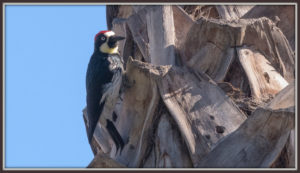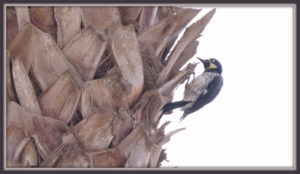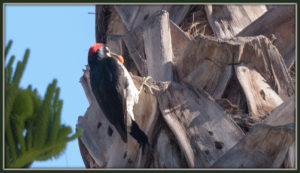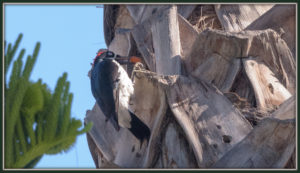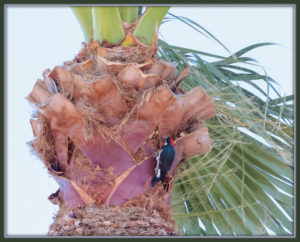Acorn Woodpeckers
Double-click on any image to view it full size. Click the back-button to return to your place on this page.
Greetings!
As you may have noticed, two Mondays went by without a post, but now I am back!
Ruthi and I went to California for a family wedding, and we added some tourist destinations to our itinerary, since we had never been to the West Coast together.
Nature photography was not at the top of our list of priorities during the trip, but we did see several interesting birds and animals – at least they were interesting to an East Coast guy! Some of them may well find their way into future posts, and one of them is the star of today’s essay.
While we were at Hearst Castle in San Simeon, I noticed a bird fly onto the trunk of a palm tree.
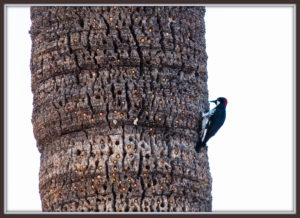
I also noticed that the palm tree trunk was riddled with holes. However, it was not until later that night that I was able to go on line and identify the bird as an Acorn Woodpecker (Melanerpes formicivorus). At a quick glance, these birds might be confused with Red-headed, or even Red-bellied Woodpeckers. But as I saw more of them, and managed to get better pictures, their faces and breast plumage are very different, and in the US they are only found on the West Coast and the extreme South West)
Image AW2 shows a male – recognizable because his red cap and white forehead meet each other. AW3 shows a female – note the black area between the white face and the red cap. AW4 shows the breast plumage. These three images (and all the others except AW1 and AW7) were taken during our visit to Catalina Island. At this point I would mention that some of these images are not of the highest technical quality. The birds had a habit of staying high up on the tree trunks – usually on the shady side of the tree so that they were in shadow with a very bright sky behind them!
But while their comical faces would be enough to make them interesting, it is their feeding habits that make them very special. As you might have figured out from their Latin species name, they do eat ants (and other insects) but they also eat acorns. But they don’t just eat them, they store them for future use.
AW5 and AW6 show a bird starting to position an acorn in a palm tree (note several other holes already drilled), and in AW7 (not the same bird or tree) you can see several acorns wedged into spaces between the frond stumps. The next two images, AW8 and AW8a
show a general view and then a close up of a “granary tree”, in which a group of these highly social birds stores perhaps thousands of acorns. In this case the tree is a conifer rather than a palm, but the palm tree in AW1 is also a granary tree, and many acorns are visible there too. The birds choose (or specially drill) a hole in which each acorn will fit tightly. However, as the acorns dry out over time, they shrink, and so the birds have to spend a lot of time moving the acorns to smaller, tighter holes. The woodpecker group will defend their cache of acorns against other birds that might try to raid the pantry. One local told us that the woodpeckers wait for insects to arrive to eat the acorns, and then eat the insects, but I have not found any corroboration for that assertion.
This next image, AW9, shows two birds on one tree, but I could not determine if they were a pair. The upper one is certainly a female.

Acorn Woodpeckers don’t just share acorns amongst members of the group – according to Wikipedia “. . . field studies have shown that breeding groups range from monogamous pairs to breeding collectives of seven males and three females, plus up to 10 nonbreeding helpers. Young from a single brood have been found with multiple paternity.” (https://en.wikipedia.org/wiki/Acorn_woodpecker).
The final two pictures show a male ( as you can now easily recognize) removing some loose material from the pantry, and then posing for the camera!
More information on these fascinating birds can be found at http://www.audubon.org/field-guide/bird/acorn-woodpecker
Have a great week!
